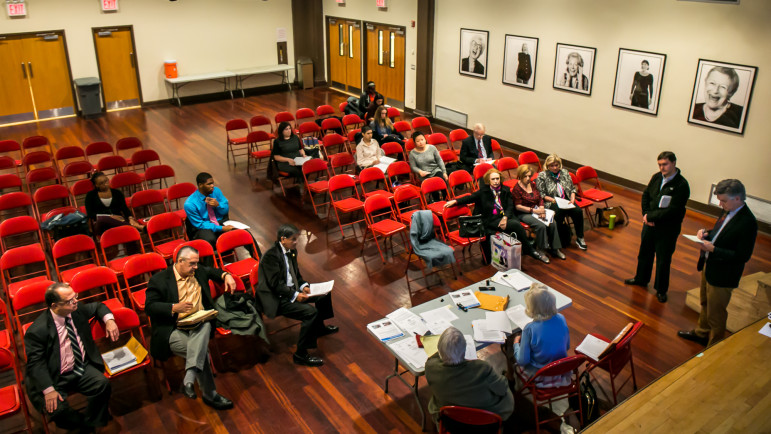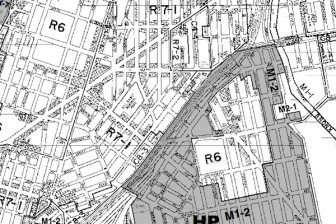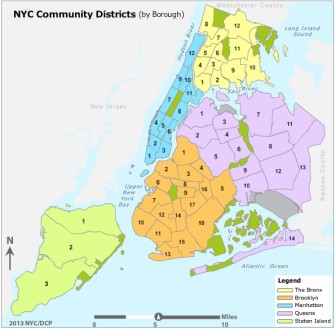
Adi Talwar
Stephen Johnson, with the Department of City Planning making a presentation on zoning to Manhattan Community Board 8 last month.
Mayor De Blasio rode to office telling “the tale of two cities,” and promising he would remedy the inequality between them. A major test of this promise is underway, as community boards across the city weigh in on proposed housing policies that the administration believes are key to addressing the city’s affordability crisis. Will De Blasio be able to convince the two cities—let alone 59 community districts—that his housing plan will benefit them all?
The first proposal, Mandatory Inclusionary Housing, would require developers to include a percentage of affordably priced units whenever the zoning designation is changed to substantially increase density. The second proposal, Zoning for Quality and Affordability, would adjust building regulations like height limitations, rules governing the set-back distance from sidewalks and parking requirements—changes, officials say, that will enable developers to build better, more affordable buildings. Brooklyn Community Board 5 and 16 are also debating a proposal that would upzone avenues, encouraging residential development in East New York and Ocean Hill.
With limited time—each district must vote by the end of November—community board members are scrambling to understand these proposals, scheduling extra meetings and town halls. While their vote is not legally binding, their opinion, as well as those of each borough president and the City Planning Commission, could influence how City Council makes the final decision next spring.
Seeking a cross section of residents’ perspectives, City Limits looked at how three community boards are reacting to the proposals. While there were significant differences—including a Not-In-My-Backyard sentiment in wealthier communities—just about all residents had the same concerns: that the proposal will not do enough to solve the affordability crisis, could further displace residents and would ultimately serve the interests of developers.
Suburban Queens board distrusts city’s intentions
“Is there any interest in bringing this over to neighborhoods with primarily one family homes?” asked Robert Block, a Queens Community Board 8 member, at the Zoning Committee meeting on Monday, October 26.
It was one of several times when City Planning’s Stephen Everett would try to convince committee members that CB 8 would not be affected by Mandatory Inclusionary Housing. “No,” he said point-blank.
“I’m going to ask: How long will it take once this program starts for it to be brought into neighborhoods with one family homes?” Block continued. “Some of our people have lived here a very long time, and they have heard politicians come up with all kinds of ideas which at first seem okay—in that they do not affect our neighborhood—and then that was changed.”
Community District 8, which includes neighborhoods like Kew Gardens Hills, Holliswood, Jamaica Estates and others, is a middle-class, racially diverse community where about half of the residents are homeowners. Over past decades, they have fought hard for zoning regulations to protect the low-rise character of the neighborhood.
“We are very concerned, as are people all over, that we do not become a high-density neighborhood, full of people and crowds,” Block explained in a later interview. He said that quality of life, the ability to find parking, and the value of homes could be affected by greater density.

The Mandatory Inclusionary Housing proposal would require a share of new housing units be income-targeted whenever a major rezoning takes place. Click here to read more about it.
Because the Department of City Planning (DCP) does not plan to rezone the area, the only way Mandatory Inclusionary Housing would actually affect this district is if a private developers applied, through the normal Uniform Land Use Review Procedure (ULURP) process, to construct higher buildings with more than ten units. Then, the new policy would kick into affect, requiring that the developer supply 25 to 30 percent of units at affordable levels. But such a private proposal is unlikely to make it through the community board anyway, given residents’ devotion to preserving the low-rise character of the district.
In general, board members and community residents voiced distrust of the city’s answers and their ability to carry out the program successfully: that the Department of Buildings would adequately enforce the new regulations, that the Board of Standards and Appeals would make wise decisions about when to grant developers a variance, and that the city would use taxpayer dollars effectively.
“We have no idea how much this is going to cost, we have no idea how you’re going to pay for it, but somehow it’s all going to [become] the burden of city taxpayers,” said committee chair Steven Konigsberg.
Others went farther, questioning the government’s reach.
“When I hear words like ‘mandatory,’ when I hear ‘improved zoning’ — that [means]…things that are shoved down our throats,” said Elaine Young, first vice president of the West Cunningham Park Civic Association. She noted a part of the mandatory inclusionary housing proposal that would allow smaller buildings to avoid the affordability requirement by paying into a housing fund. “I don’t know, isn’t that called socialism?”
Others were more concerned with the income levels reached under the proposal, and disliked that the proposal allowed developers to build an offsite affordable building—what board members began calling “poor houses.”
“I’ve been reading some pieces about this proposal from affordable housing advocates and some criticisms were…that even if this law was enforced perfectly, it may not actually achieve the policy of producing an economically diverse community because the majority of units would still be for incomes that are much higher,” said board member Bright Dae-Jung Limm.
Many members were also concerned about a provision in the second proposal, Zoning for Quality and Affordability, which would give developers in transit-rich areas the option of forgoing parking space for affordable units and senior housing. While only parts of Briarwood, in the southwest corner of community district 8, would qualify as transit-rich, board members said lack of parking is a dire issue throughout Queens, including Briarwood, where commuters often park their cars before taking transit into Manhattan.
The Committee voted 15 to 1 to oppose the mandatory inclusionary housing proposal, and unanimously to oppose Zoning for Quality and Affordability.
Upper East Siders worry over height, displacement
When affordable housing advocates say the city should be encouraging mixed-income housing development not just in poor, black neighborhoods, but in rich white neighborhoods too, they sometimes suggest the Upper East Side.
Known as one of the city’s most exclusive communities, Manhattan Community District 8 is 79 percent white, has a median income of $105,986 and a median asking rent of $2,650. Recent years have seen the construction of an increasing number of 30- to 40-foot luxury towers, with nearly 500 units authorized by new building permits in 2014. The city does not currently have plans to rezone the district. Yet, with the neighborhood already zoned for dense residential development, it is possible that mandatory inclusionary housing could apply through developer-initiated land use changes, and Zoning for Quality and Affordability provisions will immediately apply on many avenues.
Community Board 8 members are among those calling for affordable housing. In the 2016 district needs statement, they lamented that “with affordable housing becoming increasingly scarce, commercial rents escalating, and the prices of goods and services dramatically rising, our middle class residents are struggling to meet their budgets.”

Zoning for Quality and Affordability is a proposal to update the city's zoning rules on building height, setbacks and other features in order to foster more housing development. Click to read more.
This sentiment, however, did not translate into support for the mayor’s housing proposals at a Zoning and Development committee meeting on Tuesday, October 27. Though the committee has not yet voted on the proposals, they expressed many concerns—on both aesthetics and matters of justice.
Many members said provisions in Zoning for Quality and Affordability that allow 30- to 40-foot height increases for affordable senior housing facilities would destroy neighborhood quality.
“Those of us who’ve worked on the Upper East Side for more years than we can count to get contextual zones like R9X, we figured 160 [feet] for a very narrow avenue was a generous maximum height,” said co-chair Elizabeth Ashby, referring to a type of high-density residential zone that is governed by 1987 Quality Housing regulations, which include limitations on the height of buildings. “To add 45 feet, no matter what you put in it —you could put Mother Teresa in it—it still is a too-tall building.”
Others worried that provisions allowing developers to build affordable housing set back from the sidewalk would lead to an influx of street vendors—one of the board’s pet peeves.
Several Manhattan CB8 members said they might be willing to make compromises on height and setbacks if the proposals actually yielded more affordable housing, but noted inclusionary zoning programs would barely make a dent at replacing the thousands of rent stabilized and Mitchell-Lama units that have been lost in recent years.
“They’ve emptied out the people who lived in the affordable units,” said Sarah Chu. “Sure, there may be 10 or 12 affordable units within this new fancy building, but there was already a loss of 20 affordable units when this building was emptied out. It’s really hard for us to see that there’s any net gain. Unless there’s a net gain built into this, I don’t know how I could justify a positive vote for this.”
Members said the affordability levels offered in the proposal would not reach many residents. They demanded a better preservation strategy, and recommended exploring alternative methods to build affordable housing that do not rely on tax breaks.
“I’m not seeing the logic of building more market-rate housing and putting a couple of [affordable] units in there when it would be cheaper to stop the subsidies, tax all the developers at the full rate, take the tax money and build some housing,” said co-chair Elaine Walsh.
Some in East New York demand a new plan
Meanwhile, at ground zero for the city’s affordable housing plan, hundreds of East New Yorkers gathered to express their concern about the largest city intervention in the neighborhood in decades.
Over 220 East New York residents packed the auditorium of the Franklin K. Lane educational complex for Brooklyn Community Board 5’s October 28 board meeting. Officials from DCP spent an hour explaining all three proposals, including the two citywide housing programs and the East New York rezoning plan, which the city says will create affordable housing through a combination of mandatory inclusionary zoning and additional subsidies.
Next, longtime East New York politician Assemblyman Charles Barron took the mike.

Both proposals are working their way through the city's Uniform Land-Use Review Procedure. Click here to learn how it works.
“That was the Department of City Planning’s plan for East New York. Now we’re going to talk about the community plan for East New York,” said Barron to overwhelming applause. He lambasted the city’s plan for encouraging market-rate growth that would displace existing residences.
“They’re going to tell you that unless there’s a diversity of incomes, we’re not going to be able to build our economy,” he said. “What this means, translated? You need white folk down here. If you want to have an economy, you need white folk here. If you want to get transit stuff, you need white folk to come in. If you want to get a new school, you need white folk to come in…They want to make this place look better, to gentrify it.”
Assemblyman Barron and his wife Councilwoman Inez Barron presented a joint plan demanding that 100 percent of the 6,300 projected new units be affordable to low-income residents. This included 30 percent of units for families earning $23,000 and below, 30 percent for families making between $23,000 to $34,000, 20 percent for those between $34,000 and $50,000 and 20 percent for those earning between $50,000 and $65,000.
The city’s proposal would set aside a lower share of units to each of the income groups under $50,000, and permit 50 percent of units to be market rate. De Blasio’s plan would target about 5 percent of units for families of four earning between $21,189 and $25,900, 7.5 percent for those earning between $30,789 an $34,520, 7.5 percent for those earning between $38,469 and $43,150, 20 to 30 percent for those earning between $46,183 and $51,780, up to 10 percent for those earning between $69,257 and $77,670, and the remaining 50 percent for market-rate housing. Deeper levels of affordability will be required on public sites.
The Barrons’ plan is the most ambitious proposal so far released by public officials or major advocacy coalitions in the neighborhood, but its success may depend on the support of Councilman Rafael Espinal, who represents the district covering most of the rezoning territory and who has not yet established a clear position on the city’s plan. (He did not speak at the meeting, though representatives said he was in attendance.)
Residents lined up to voice their concerns, concerned about both the affordability levels in the city’s plan and how the plan would address the neighborhood’s existing dire needs. A teacher at P.S. 202 demanded a financial commitment to addressing school overcrowding, which the city has already identified as an issue that could be exacerbated by new development. A 9th grader asked who would put up East New York families when they were unable to pay the rent. A representative from the Wal-Mart Free Coalition asked the city to make a commitment to providing East New Yorkers with stable, living wage jobs. A family advocate at Tomorrow’s Leaders NYC, a youth mentoring organization that serves overage middle-school students, said that the money spent on the plan might be better spent on programs that help struggling youth avoid the streets.
The Coalition for Community Advancement, which has developed an alternative plan that they say addresses residents’ concerns, is demanding that DCP conduct a fair housing analysis of the city plan to determine its impact on residential segregation. Coalition member Brother Paul Muhammad praised Martin Luther King Jr. for his fight to end redlining and housing segregation through the Fair Housing Act.
“We have rights that need to be protected as a people,” he said.
City Limits conducted a survey to determine which community boards have taken a vote on the two proposals. We determined the status of 24 of 59 boards, most of which have not yet taken a vote. The following results were obtained:
VOTED AGAINST BOTH
Brooklyn CB 15, Bronx CB 11, Queens CB 11, Queens CB 12, Queens CB8 Zoning Committee, Bronx CB 12
VOTED FOR BOTH
Bronx CB 6
VOTED FOR MIH but not ZQA
Brooklyn CB2 Land Use Committee
City Limits’ coverage of housing policy is supported by the Charles H. Revson Foundation.
* * * *










6 thoughts on “How are NYC’s Community Boards Reacting to de Blasio’s Housing Proposals?”
I’m confused by this part of the process. Does every CB have to take a vote on this or just those CBs in which ‘affordable’ housing is proposed?
Every CB must deliberate and vote on the two citywide proposals (MIH and ZQA), regardless of whether a neighborhood-specific development project with affordable housing is being proposed by the city in the CB’s particular district.
The Land Use Committee of Brooklyn Community Board 2 voted for MIH but against ZQA. The full board will vote on the matters on Tuesday, November 10 (6:00 pm,Brooklyn Law School, 250 Joralemon Street). native, the two text amendments are multifaceted and affect almost every community district in the city.
Thanks, but I must be in one of the CBs (Staten Island-2) not affected by it. Haven’t read anything about it in print or online. Most of SI-2 is zoned R3X or R3-1. I read the ZQA proposals a few months ago and emailed the city back in April asking if indeed R1, R2 and R3 residential areas were included, of course I never received a reply.
Am I right in assuming(ass+u+me) thinking only Landmark Districts and only them are off the list?
Pingback: Bronx Beep Diaz Rejects de Blasio’s Proposed Zoning Changes | City Limits